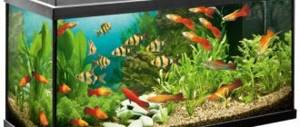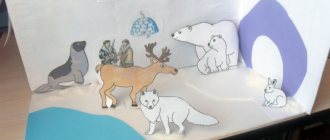Water cycle at home
One of the best ways to learn about the water cycle is to see it in action. The demonstration can show all four stages of the hydrological cycle: evaporation, condensation, precipitation and accumulation. Although we see some of the steps of the water cycle in our daily lives, demonstrating the process in a container provides a better understanding of it. The experience will be interesting not only for schoolchildren, it will also captivate preschool children.
Below is a simple way to create an artificial water cycle at home.
Take a large plastic container and fill it 1/4 full with hot water. (Hot water is not essential, but it does promote rapid evaporation.) Add a few teaspoons of salt to simulate the salinity of the oceans. Place another smaller container inside the larger container of water. Position the smaller one so that it is higher than the surrounding salt water and remains empty. This container will eventually collect sediment.
Cover the container tightly with transparent film. The film plays the role of clouds floating above the Earth, and creates a place for condensation to collect. Place a few ice cubes on top of the film. The ice cools the “clouds”, making it easier for the evaporated water to condense.
Wait for the ice to melt. The amount of waiting time depends on how hot the water was at the beginning of the experiment, as well as the temperature of the room. This may take from a few minutes to an hour. After a while you should see condensation under the film. Then precipitation will begin. Through the clear sides of the container, you will be able to see tiny condensed “raindrops” that will drip into the smaller container. This will be precipitation.
With a few simple steps, you can create a water cycle at home.
Didn't find what you were looking for? Use the site search form
Lesson #12. "Transformation and cycle of water." Section “This amazing nature”, 3rd grade
Film lesson book “The world around us” 3rd grade
Lesson type:
combined
Target
— formation of a holistic picture of the world and awareness of man’s place in it based on the unity of rational-scientific knowledge and the child’s emotional and value-based understanding of his personal experience of communicating with people and nature;
Problem:
what is the water cycle in nature?
Tasks:
teach to identify different states of water and the reasons for the formation of clouds and rainfall.
Subject results
will learn
- distinguish between three states of water,
- formulate, based on observation, a conclusion about the causes of cloud formation and rainfall;
-model the water cycle;
-use textbook texts and illustrations to find answers to questions.
Universal educational activities (UUD)
Regulatory:
transform a practical task into a cognitive one during an educational experiment.
Cognitive:
formulate, based on observation, a conclusion about the causes of cloud formation and rainfall
Communicative:
be active in interaction to solve communicative and cognitive problems: mastering modeling activities.
Personal results
Formation of a holistic view of the world. Development of motives for educational activities
Basic concepts and definitions
Three states of water. Water cycle in nature
.
Checking readiness to learn new material
Remember the properties of snow and ice. Answer the questions: 1. What are clouds made of? 2. Why is it raining? 3. How is snow formed?
Think about the three states water exists in nature.
Learning new material
Transformations
and water
cycle THREE
states of water
At a temperature of 0°C, water turns into ice. This happens in a river, a lake, and a puddle. Tiny pieces of ice also form high in the clouds. There they enlarge, turn into snowflakes and fall to the ground. This is how snow is formed. Ice and snow are water in a solid state.
We wiped the chalkboard with a wet rag.
A few minutes passed and the board became dry. The water evaporated from it, that is, it turned into steam - a transparent, colorless gas. Water vapor is water in a gaseous state.
In nature, water constantly evaporates from the surface of seas, rivers, lakes, and soil. Therefore, the air always contains invisible water vapor.
You know that water contracts when cooled. It would seem that when it turns into ice, it should shrink especially strongly. In fact, the opposite happens: when water turns into ice, it expands! Because of this, water pipes sometimes burst in winter. The water in them freezes and, expanding, puts so much pressure on the pipes that they burst.
Three
states of water
How water becomes steam and dew
WATER
CYCLE Let's do an experiment. We will heat water over which a cold object is fixed, for example a plate of ice. Soon the underside of the plate will become damp. We will see drops on it that will begin to fall down. How can we explain what we observed?
Water evaporates quickly when heated. Invisible steam rises up. When it comes into contact with a cold object, it turns back into water. Droplets of water increase, break off and fall. So, using experience, we simulated the water cycle in nature.
From the surface of reservoirs and soil, water rises in the form of steam. The air high above the ground is always cold (it is no coincidence that there is usually ice and snow on mountain peaks). The steam cools there and forms many water droplets or tiny pieces of ice. Clouds are formed from these droplets and pieces of ice. The clouds are light, and the wind sometimes carries them over very long distances. From the clouds, water returns to the earth in the form of rain and snow.
water cycle .
The water cycle in nature .
Comprehension and understanding of acquired knowledge
Water cycle in nature
Look at the picture. What does it show? What do the arrows in this picture mean? Explain what happens to water particles when steam and ice form.
Use a diagram to explain why water expands when it turns into ice. (Note the special arrangement of the ice particles and the spaces created between them.)
Consider the diagram. Tell us about the water cycle in nature. Ask other guys to test you.
Conclusion
Water
It exists in nature in three states:
liquid, solid and gaseous.
Water constantly cycles: it evaporates from the surface of the earth, forms clouds, and returns to the earth in the form of rain and snow.
Independent application of knowledge
1. In what three states is water found in nature? 2. Under what conditions does ice form? Why is he melting? 3. How is steam formed? Under what condition does steam turn into liquid water? 4. How does the water cycle occur in nature? In what ways did we model it?
Homework assignments
1.Write in the dictionary: state, evaporation, cycle.
2.Make a model of the water cycle in nature from plasticine on a board or plywood. Using this model, tell us about the water cycle.
Information sources
:
A. A. Pleshakov textbook, workbook The world around us, grade 3 Moscow
"Enlightenment" 2014
YouTube
website : https://www.youtube.com/
Hosting of presentations
around the world
- https://ppt4web.ru/nachalnaja-shkola/prezentacija-k-uroku-okruzhajushhego-mira-vo-klasse-chto-takoe-ehkonomika.html
Water Desalination Project
Water is a very important natural resource. The earth is covered with water. However, approximately 97% of the world's oceans are salt water. This means that most of the water on Earth is undrinkable. Through a process known as saltwater desalination, it is possible to remove the salt from it, turning it into fresh water. Desalination plants, in the form of complex plants located around the world, play an important role in conserving water supplies.
During this experiment, you will find out how sea water is desalinated and converted into fresh water suitable for consumption. You will also create a model of the water cycle in nature and use its principles.
What we need:
- cellophane;
- stationery eraser;
- spoon;
- Bowl;
- small plastic container;
- salt;
- straw (tube);
- modeling clay;
- water.
Progress of the experiment:
- Add 2 full tablespoons of salt to the water and stir. Take a straw and taste the salt solution. But never taste anything while experimenting unless specifically instructed to do so!
- Smooth out a small piece of clay on the bottom of the bowl.
- Pour salt water into the bowl (about 2.5 cm).
- Place a small container on the clay inside a bowl of salt water so that it does not move. It must be above the water level and not contain water.
- Stretch the cellophane over the bowl. The cellophane should hang slightly, but not touch the water. Attach the cellophane with an elastic band.
- Make a small clay ball. Place it on the cellophane, carefully positioning it over a small container.
- Place the container in the sun all day.
- Make a guess. What do you think will happen?
- The next day, look closely at the bowl, cellophane, and small container. Record your observations.
- There was no water in the small container. How did she end up there? Using a straw (tube), taste the water from a small container. What does it taste like: salty or fresh?
- How did this happen? This project shows the natural water cycle in action. The water has evaporated, leaving condensation on the cellophane. The fresh water then moved inside the small container (similar to precipitation).
- Draw a model of the water cycle in nature in the form of an illustration, noting the paths taken by salt and fresh water.
Conclusion:
What happens during the water cycle? How is the water cycle used for desalination? How does salt water become fresh? What methods exist for desalinating seawater?
Water Cycle Project
The water cycle is the movement of water on Earth. The largest amount of water is collected in the oceans. There are many small processes by which water moves from one place to another. However, there are only a few main processes on which the movement of water on the planet is based.
Evaporation is the process during which water molecules in the liquid state receive enough energy to evaporate or turn into a gas. When the steam cools, the water condenses or turns back into a liquid. We may see condensation on the surface of a glass of cold water or in the sky in the form of clouds. Atmospheric precipitation is the process during which condensed water that formed clouds falls to the ground, for example, in the form of rain.
The goal of the project is to observe the process of evaporation and condensation under different conditions.
What we need:
- a glass jar with a metal lid (a jar with a screw top is best);
- ice cubes;
- water;
- stopwatch;
- thermometer.
Progress of the experiment:
- Pour water into a glass jar 1 cm deep from the bottom. Screw on the lid.
- Place ice cubes on the metal lid.
- Measure the temperature inside the room.
- Start the stopwatch. Determine how long it takes for the ice cubes to completely melt.
- Carefully lift the jar, keeping it parallel to the floor, and look at the bottom of the lid from the inside. Record your observations. What do you see? If possible, take a photo or a quick sketch.
- Tilt the jar slightly so that a few drops from the lid are grouped together. What happened?
- Repeat the experiment outside during warm, sunny weather and also in a cool, dark place.
Conclusion:
By conducting this experiment, based on knowledge about the water cycle in nature, you will notice that water will evaporate faster in warm conditions, and slower in cool conditions. The water condenses and droplets form on the inside of the lid. If you tilt the jar to the side, the small droplets formed during the condensation process come together. When they get large enough, they fall to the bottom of the jar. Why? Warmer ice cubes will melt faster because the temperature differences between the environment and the cubes are greater. In addition, in warm weather water evaporates faster. Evaporation occurs when molecules receive enough energy to change into a vapor or gaseous state. In a warm environment, air contains more heat energy, which facilitates the transfer of water molecules. This allows more water molecules to be converted into steam. The evaporated water inside the jar forms condensation on the cool metal lid.
Condensate, which when cooled from a gaseous state again turns into a liquid, is the antonym of steam. The ice cooled the metal lid, causing the water to change from a gaseous state to condensate.
At room temperature and cold you will get identical results. But the ice will melt more slowly, and the amount of steam and condensate will be less.
If you tilt the jar to the side, the small drops that formed on the lid during condensation will combine. The same thing happens when precipitation forms. The condensation droplets that form clouds eventually become heavy enough to fall to the ground as rain. At low temperatures they form hail or snow.








